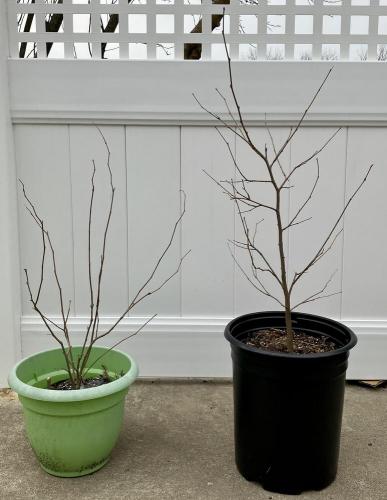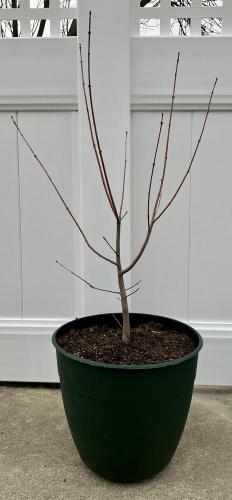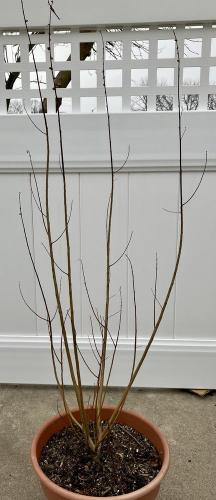- Does anyone have advice for what size container these trees should be planted in to allow for sustained growth? (current pics attached - yes, the foldgers one is ridiculous) What size container is appropriate is a function of the size of the plant's root mass and the physical properties of the grow medium. The more water a medium holds, the more critical pot size becomes. Case in point: a grow medium which holds little to no excess water (called perched water) will allow you to plant a seed or seedling in a 55 gallon drum filled to the brim with no worry the plant will be over-potted (in a pot too large, 'too large' being based on the fact that too much water in a medium limits oxygen essential to normal root function, thereby robbing the plant of some to a great deal of its potential in terms of growth, vitality (health), it's ability to defend itself against diseases and insect predation, and often - eye appeal. Using a smaller pot when the grow medium is overly water-retentive is an attempt to mitigate the limitations imposed by over-watering; this, because how much excess water held in a a medium is directly linked to the volume of medium. A smaller volume of medium = a smaller 'reservoir' of excess water = air/oxygen returning to the soil sooner = less lost potential or root damage.
Using a smaller volume of medium to avoid over-watering creates a dilemma. It means the roots colonize the soil volume faster which leads to root congestion which can also be severely limiting. It would appear that it would put every grower on the horns of said dilemma - do I use a small volume of soil as a strategy to avoid over-watering, resulting in early root congestion or do I use a large volume of soil in a larger container as an attempt to avoid early root congestion, but in doing so set the stage for root function/health issues. The best answer is neither. Using a grow medium that drains so well it allows you to use a large container removes the dilemma entirely. It also makes watering correctly and fertilizing appropriately much easier.
<b>- If they have been in the same soil since initial transplant, I imagine the nutrients are now or soon will be depleted. How often must soil be changed for container trees? If they have been in the same media for more than a year or two, the larger issue is the root congestion. Severe root congestion can rob your plant of 100% of it's growth potential; and it could be argued that it could rob the plant in excess of 100% of its growth potential. True growth is a measure of the increase in the weight of the dry mass of a plant's living parts.
Plants are shedding organisms.When they are unable to create more food/energy through photosynthesis than they burn during respiration, they shed parts. If a plant is shedding more vegetative mass than it's putting on in the form of new leaves and branch extension, it's going backward.
In a perfect world, your primary consideration when it comes to grow media for containers is the mediums structure and how long it can retain that structure. More specifically, it would be the medium's ability to hold a favorable ratio of water to air. Nutrition, as supplied by the medium itself, would be of very little concern because the grower should shoulder that responsibility by selecting and using an appropriate fertilizer at appropriate intervals. Ask if you want help or suggestions about fertilizing.
- Do trees "need" to be pruned to grow well in containers? The top doesn't, but the bottom (roots) does.</b> I don't know how continuous branching does/does not impact overall strength and growth rate. Let's first define what it means to "grow well". To me, it means the plant is achieving about as much of it's genetic potential as it's reasonable to achieve w/o resorting to heroic effort. Defining the term is important because growers have different standards and defining the perspective from which the topic is viewed. The plant should look healthy, putting on a reasonable amount of growth, and be free of insects and diseases. A healthy root system is prerequisite to a healthy plant - can't have one w/o the other.
To be at their best, plant should be free of root congestion. To achieve that, trees should be repotted (or divided where applicable) on regular basis. Repotting consists of removing all or most of the grow medium, pruning problem roots and many of the large roots that serve primarily as plumbing, changing the grow medium, and returning the plant to a pot size-appropriate to size of the root mass and how much water the medium holds.
When it comes to the the above ground parts, the more leaf surface you can make the tree put on, the faster it will grow. Each leaf is a food factory, producing the plant's true food (sugar) through the miracle of photosynthesis. In terms of growth, pruning the top is always limiting; so if you're going for maximum growth, prune as little as you can, but do make sure you have a strategy with regard to your ability to fulfill the vision you have of the tree. Don't let things get so out of hand you would need an arborist to bail you out.
- Lastly, one of the black willows has an interesting habit of growing new trunks every year, with the old ones dying. I assume this isn't normal - any idea why they keep cycling like this? The roots are clearly strong enough to keep pushing up new trunks each year.
I don't know much about black willow, but I do know willows often have insect and disease issues, not to mention some trees are commonly known for shedding branches with the underling cause often filed under 'idiopathic'. That said, being the trunk is dying back, it might have something to do with the tree going too dry in the winter? Or, trees in containers are way ahead of their counterparts in the landscape when it comes to the spring push of leaves. If you leave the tree outside and it wakes up and starts to grow, only to be hit with a hard freeze after that occurs. I would expect it to cause the top to die back, which would account for the shrubby growth.
Al





